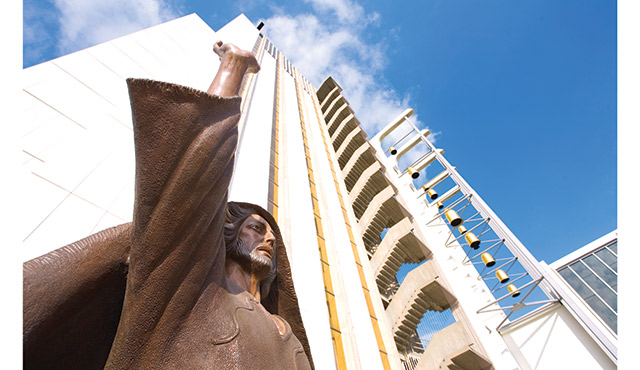What was once the tallest building in Orange County, the 13-floor Tower of Hope remains an imposing beacon with its soaring cross piercing the blue sky, reminding those who gaze upward that there are yet still some structures telling us there is more to this world than the tangible. Built in 1968 by the late Dr. Robert Schuller and architect Richard Neutra, the tower is now part of the spiritual center of Catholic Orange County, the Christ Cathedral campus. If you were to stand at the intersection just outside, you’ll see the awestruck faces of motorists who can’t help but steal a glance at the architecture.
I am fortunate to work in the Tower of Hope, for EWTN’s West Coast Studio, located on the 8th floor.
When ascending the elevator, one can see the landscape of sprawling structures and human activity below—and on clear days as far out as Catalina Island. But as part of a physical and dietary overhaul some time ago, I adapted to the routine of stair climbing to the 8th floor. 16 staircases, 160 steps. It adds a couple extra minutes, but what was once a surefire way to quickly be gasping for breath is now a requisite part of any day on the campus. I mention this because of the quiet, unexpected spiritual odyssey that ensued.
Just as one sees more interesting details on foot than in a car, the nuances of each staircase—the way the light shines through each floor window, the sporadic marks made over the decades on the concrete stairs, the intricate, industrial serial numbers on the fiber connectivity tubing—would each become a somewhat welcomed sight during my morning stair climbing ritual. Looking out each window as one floor gave way to the other, I could see below those who made visiting the grounds a regular practice: the young man saying his devotions before the Holy Family statues, the elderly woman unfailing each day with her rosary, all while the diligent, anonymous construction workers labor on transforming Dr. Schuller’s Crystal Cathedral into a new home for the Eucharistic Lord and His people. They are contributing perhaps without knowing to timeless Catholic tradition: just as the breathtaking Gothic cathedrals of medieval days were shaped from nothing by nameless hands, so too does it continue today. Nameless, maybe, but their contribution promises a testament that will impact generations.
Meanwhile, over time it dawned on me: What if stair climbing went to a deeper, more meditative level than the physical exercise that it was? Could it become a form of prayer? As each staircase is 10 steps, naturally a decade on a rosary came to mind, and naturally meditations on Our Lady organically unfolded. And if anyone has ascended the steps of the Scala Sancta in Rome, the famous 28 steps purportedly brought from Jerusalem to Rome by St. Helena in 326 AD that Jesus climbed to meet Pilate centuries earlier, one knows that where there is a staircase, there Christ’s Passion is not too far from memory.
Here in the Tower of Hope’s narrow, quiet, yet massive stairwell angling upwards to where the cross symbolize to those both conscious or yet unaware of the consequence for all that was the birth of Jesus in this world, I dedicated what was often a monotonous task of ascending the 160 steps to Our Lady. Our Lady of the Staircase, I dubbed to myself. It would be my little title for the Blessed Mother, a secret only she and I would share.
And then I stumbled upon Michelangelo, who had a similar idea—and the capability of articulating his idea through his hands, starting with one early masterpiece.
My foray into the works of Michelangelo was not unlike the mature rediscovery of the beauty of the faith that conversion allows: what was familiar and mundane was suddenly fresh and rich. Somehow, Michelangelo’s sculptures and frescoes suddenly stretched from the fuzzy past of art history, where names and dates are to be memorized and forgotten, into things living and dynamic if for no other reason than the nagging divine breadcrumb: why Michelangelo? I finally realized why: the leap was stimulated by Michelangelo’s first sculpture—at age seventeen—from 1491, a work of interest not only to the art historian but one that stretched across the centuries and miles to my own peculiar devotion in the Tower of Hope stairwell.
For the name of this relief sculpture was as if Michelangelo recognized it himself: Madonna della Scala.
Madonna of the Stairs.
I pored over the work. I am not an art expert, but one can instantly sense the unique Michelangelo touch he was already cultivating as a teenager, particularly in the portrayal of the child Jesus: though we do not see His face, as it is snuggled in His mother’s bosom, His back and arm muscles are pronounced, not unlike Michelangelo’s later sculpture of Moses. Mary, depicted in profile, is the dominant figure in the frame. Behind her, children play on a staircase, a young boy mischievously leaning over the rail.
Probably due to his future achievements, Michelangelo made no mention of the relief sculpture throughout his life. It only became known after his death, and was housed in the Medici household. It is now displayed in Casa Buonarotti, the Florentine museum. Perhaps it was intended to be Michelangelo’s own little secret.
But now I think about him, art, Our Lady, and the mystery and vibrancy that is faith when it leaps from the pages of knowledge into the intimacy of personal encounter. And then I am grateful Michelangelo’s secret is shared with the world.
And I continue climbing the Tower of Hope.
James Day is EWTN Operations Manager at the Diocese of Orange and a contributor to Orange County Catholic.

